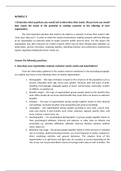Exam (elaborations)
NURS 5334 Final questions and answers 100% correct 2022
- Course
- Institution
NURS 5334 Final questions and answers 100% correct 2022Prescribing basics Prescribing is regulated by state BON Proper RX Providers name and address, Telephone DEA Pt name/DOB/Addres Name of Drug, strength, SIG(directions) with indication/Route and frequency, Quantity and signature. ...
[Show more]




